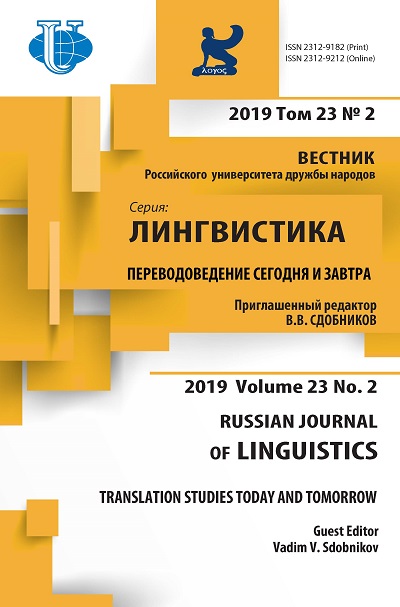Mode in Arabic-English Translation: with Reference to the Quran
- 作者: Najjar I.I.1, Kwee S.B.1, Abu al-haj T.A.1
-
隶属关系:
- University of Malaya
- 期: 卷 23, 编号 2 (2019): Translation studies today and tomorrow
- 页面: 509-522
- 栏目: 翻译
- URL: https://journals.rudn.ru/linguistics/article/view/21220
- DOI: https://doi.org/10.22363/2312-9182-2019-23-2-509-522
如何引用文章
全文:
详细
A rhetorical question has the form of a question but does not perform its function, i.e. does not seek any information but rather, is used to give a specific or rhetoric function such as denial, assertion, testing, equalization and negation. The present study investigates the two English translations that were used in the translation of the Quranic rhetorical questions. In a nutshell, this is a comparative study that aims to discover if the grammatical shifts that had occurred in the two English translations would have an effect on the denial, assertion, testing, and equalization and negation modes of the Quranic rhetorical questions. For this purpose, we had adopted the register theory of Halliday and Hassan (1985) as well as the translation shifts of Catford (1965) in the comparison of the two English translations, namely the Koran Interpreted that was authored by Arberry (1955) and the Noble Quran: English translation of the meanings and commentary as transcribed by al-Hilali and Khan (1996). According to the analyses, the occurrence of grammatical shifts between the two translations had in fact affected the mode of the ST rhetorical questions, their rhetorical meanings and consequently, issues on mode sustenance. Therefore, it can be said that the register theory of Halliday and Hassan (1985) had been a beneficial tool used in the analysis of the translation process.
作者简介
Ibrahim Najjar
University of Malaya
编辑信件的主要联系方式.
Email: ibrahim99@siswa.um.edu.my
Ph.D. in Translation Studies, Faculty of Languages and Linguistics, University of Malaya
University Str., Kuala Lumpur, 50603, MalaysiaSoh Kwee
University of Malaya
Email: bksoh@um.edu.my
Ph.D., Assistant Professor, Faculty of Languages and Linguistics, University of Malaya
University Str., Kuala Lumpur, 50603, MalaysiaThabet Abu al-haj
University of Malaya
Email: thabet2012@um.edu.my
Ph.D., Associate Professor, Department of the Quran and Hadith, Academy of Islamic Studies, University of Malaya
University Str., Kuala Lumpur, 50603, Malaysia参考
- Abioye, Taiwo (2011). Preference for rhetorical questions as an index of textual message effectiveness. International Journal of Humanities and Social Science. V. 1. No. 1.
- Arberry, Arthur John (1955). The Koran Interpreted: London: Allen & Unwin.
- Bhattasali, Shohini, Cytryn, Jeremy, Feldman, Elana, & Park, Joonsuck (2015). Automatic identification of rhetorical questions. In ACL.
- Catford, John Cunnison (1965). A Linguistic theory of translation. London: Oxford University.
- Hackstein, Olav (2004). Rhetorical questions and the grammaticalization of interrogative pronouns as conjunctions in Indo-European. In Adam Hyllested, Anders Richard Jørgensen, Jenny Helena Larsson et Thomas Olander (eds.), Per Aspera Ad Asteriscos, Studia Indogermanica in honorem Jens Elmegård Rasmussen sexagenarii Idibus Martiis anno MMIV.
- Halliday, Michael Alexander Kirkwood, & Hassan, Ruqaiya (1985). Language, Context and Text: Aspects of Language in Social - Semiotic Perspective. Waurn Ponds, Victoria: Deakin.
- IIie, Cornelia (1994). What else can I Tell you? A Pragmatic study of English rhetorical questions as discursive and argumentative acts. Stockholm, Almqvist & Wiksell International.
- al-Hilali, Muhammad Taqi-ud-Din, & Khan, Muhammad Muhsin (1996). The Noble Qur'an: English Translation of the Meanings and Commentary. King Fahad Complex for the Printing of the Holy Quran. Madinah, K.S.A.
- Larson, Mildred (1974). The communicative situation and rhetorical questions. Notes on Linguistics, 9, 14-18.
- Larson, Mildred (1984). Meaning-Based Translation: A Guide to cross-language equivalence. New York: University Press of America.
- al-Malik, Fahad M. (1995). Performative utterances: their basic and secondary meanings with reference to five English translations of the meanings of the holy Qur'an. Unpublished PhD Thesis, Durham University, UK.
- Ranganath, Suhas, Hu, Xia, Tang, Jiliang, Wang, Suhang, & Liu, Huan (2016). Identifying rhetorical questions in social media. In ICWSM.
- el-Sa’adany, Kamel Abdelbadie (2010). Function of interrogations in the Hadith: a sociolinguistic study. Retrieved from www.docplayer.net.
- Siemund, Peter (2001). Interrogative constructions, In Haspelmath et al. (eds.). Language Typology and Language Universals. Berlin: Mouton de Gruyter, PP.1010-1028.
- Shore, Susanna (2001). “Teaching Translation” in exploring translation and multilingual text production: beyond content, Erich Steiner and Collin Yallop (eds.), Berlin: Mouton de Gruyter, 249-76.
- Vinay, Jean-Paul, & Darbelnet, Jean (1995). Comparative Stylistic of French and English: A Methodology for Translation. Amsterdam: John Benjamins, The Netherlands.
- Abbas, Fadhil (1997). Albalagha fonunha wa afnanuha: ilmualm’ani. Daru alfurqan.
- Abu-Haiyan, Muhammad (1993). Tafsir albahar almuhit. Dar alkutub alilmiah, Beirut, Lebanon.
- Aida, Nagish (2012). Uslub alistifham fi alahadith alnabuyah fi riadh alsalhin: dirasa nahuwih balaghya. Unpublished M.A dissertation, Moluod Mu’amari University, Algeria.
- al-Balakhi, Muhammad (2007). Asalyib al-istifham fi al-bahith al-balaghi wa asraruha fi al-quran alkarim. Unpublished PhD Thesis, the international Islamic University, Pakistan.
- al-Amri, Shakir, Khursindi, Mahmoud, & Tarhami, Sumayah (2012). Tajahul al-arif fi alquran: ist’malatuhu wa aghrathuhu albalaghya. Majalat dirasat alogat alarabya wa adabuha.
- Bofama, Sarah (2014). Uslub alistifham fi qisat Ibrahim. Dirasah nahuwya balaghya. Unpublished M.A dissertation, Abdul Qadhir University, Algeria.
- al-Fayroz Abadi, Muhammad (2001). Alqamos almuhit. Dar ihya’a alturath alarabi. Beirut. Lebanon.
- Foda, AbdulAlim (1953). Asalib alistifham fi al-Quran. A Published PhD Thesis, Cairo, Dar-alsha’ab.
- Ibn Ashur, Muhmmad Al-Tahir (1984). Tafser al tahrir wa altanwir. Aldar at-tunisya llnashir.
- Ibn Fares, Ahmad (1997). al sahibi fi fiqh alugah alarabya wa masa’iluha wa sunan alArab fi Kalamuha. Dar al Kutub alilmyah.
- Ibn Khalawyh, Hussain (1996). Alhujah fi alqira’at alsaba’a. Beirut. Mu’asasat elrisalah.
- Rajdal, Halimah (2013). Balaghat alistifham wa dalalatuhu fi al-Quran alkareem. Unpublished M.A dissertation, Wahran University, Algeria.
- Sagir, Sa’diyah (2015). Muqaraba Dalaliya fi Ma’ani al-Istifham al-Balaghya. Biblid.
- al-Soyoti, JalalAldin (1985). Al-ishbah wa al-nathair fi alnahu. Altaba alwla. Muasasat Risalit Beirut.
- al-Zamakhshri, Mahmoud (2009). Tafseer al-kashaf an haqaiq altanzeel wa oyon alaqaweel fi wujuh alta’weel. Dar almarifa.














